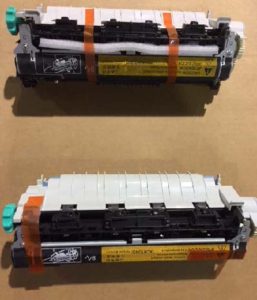By Jose A. Hernandez, Encompass Supply Chain Solutions, Inc.
The Internet has evolved since the mid-1990s, enabling us to find the closest pizza joint, research causes for that nagging ache, play World of Warcraft against someone in Yugoslavia and purchase anything from accordions to zebras (for real). The web may be a boon for gamers and exotic animal dealers, but for the OEM imaging parts market…not so much.

OEM fuser and its cloned version
Until the early 2000s, there was a clearly defined process for parts procurement through specific authorized distribution channels. Pricing wasn’t a primary concern, and the demand was strong for genuine, original parts – especially since no cheaper alternatives were available.
It was inevitable that the global reach of the Internet would become a market disrupter for genuine OEM parts channel partners – changing the landscape of how imaging parts and services are now procured.
You can search the web for popular laser printer parts such as maintenance kits and fusers and find a menagerie of options for just about any top brand. Many of the products shown online look as if they rolled right out of branded factories, making it difficult to distinguish original parts from generic if you’re not a seasoned parts distributor or technician.
The imaging market is further compressed by the world’s move to digital platforms, reducing the need for printed paper. While many businesses – such as banks, insurance companies, law firms and real estate firms – are still heavily paper-based, they are all seeking bottom line savings. U.S. governmental agencies and Fortune 500 companies are about the only entities demanding OEM product due to potential liability issues related to alternative products.
There used to be a time when authorized channels were respected, but these lines are now blurred by the globalization of e-commerce and the net. However, there is still hope for a resurgence of the authorized OEM parts channel. We just need both manufacturers and channel partners working together to create targeted strategies to challenge the growth of the gray market.
Manufacturers could apply some of the same technologies used in today’s toner cartridges to challenge the unauthorized refurbishment of fusers and manufacturing of cloned products. They should also consider ensuring original products are somewhat more price competitive to gray market parts.
Educating consumers on compliance for product maintenance in their install base is also key. Manufacturers could additionally promote compliance at the channel partner and client level and tie use of authorized parts to their business review for IT procurement. Then, reward proper behavior with incentives to use genuine parts over the term of their product deployment.
More attention is needed toward changing the current market trend of parts divergence from the authorized channels of parts distribution. Cloned imaging products have got a strong hold on the market, but that grip can be loosened with some collaborative efforts among manufacturers and their partners.


Leave A Comment
You must be logged in to post a comment.